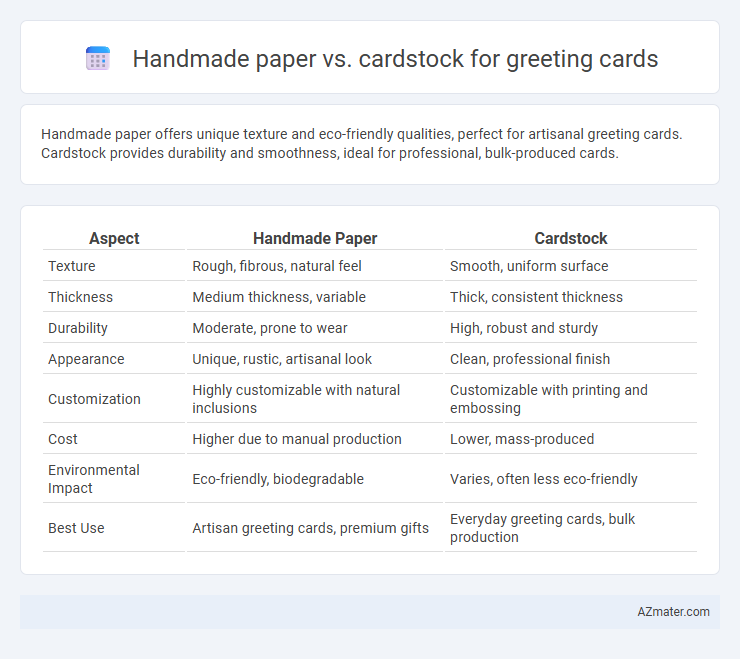Handmade paper offers unique texture and eco-friendly qualities, perfect for artisanal greeting cards. Cardstock provides durability and smoothness, ideal for professional, bulk-produced cards.
Table of Comparison
| Aspect | Handmade Paper | Cardstock |
|---|---|---|
| Texture | Rough, fibrous, natural feel | Smooth, uniform surface |
| Thickness | Medium thickness, variable | Thick, consistent thickness |
| Durability | Moderate, prone to wear | High, robust and sturdy |
| Appearance | Unique, rustic, artisanal look | Clean, professional finish |
| Customization | Highly customizable with natural inclusions | Customizable with printing and embossing |
| Cost | Higher due to manual production | Lower, mass-produced |
| Environmental Impact | Eco-friendly, biodegradable | Varies, often less eco-friendly |
| Best Use | Artisan greeting cards, premium gifts | Everyday greeting cards, bulk production |
Introduction to Handmade Paper and Cardstock
Handmade paper, crafted from natural fibers like cotton or recycled materials, offers a unique texture and organic aesthetic that enhances the tactile experience of greeting cards. Cardstock, a heavier and more durable paper type, provides structure and a smooth surface ideal for printing and embossing. Both materials serve distinct purposes in greeting card design, balancing artistry and functionality depending on the desired finish and durability.
Material Composition and Production Processes
Handmade paper is crafted from natural fibers such as cotton, linen, or recycled pulp, resulting in unique texture and irregular thickness due to traditional techniques like sheet forming and pressing. In contrast, cardstock is typically made from wood pulp or a blend of cellulose fibers processed through industrial methods, including pulping, pressing, and calendering, yielding a smooth, uniform surface ideal for printing. The natural composition and artisanal production of handmade paper offer distinct tactile qualities, whereas cardstock's machine-made consistency provides durability and precision in greeting card manufacturing.
Texture and Visual Appeal Comparison
Handmade paper offers a unique, textured surface with natural fibers that create an organic, artisanal charm, enhancing the greeting card's tactile quality and visual depth. Cardstock provides a smooth, uniform finish with consistent thickness, allowing for vibrant, crisp printing and bold color presentation. The choice between handmade paper and cardstock depends on whether a rustic, handcrafted feel or a polished, professional look is desired for the greeting card.
Durability and Longevity of Greeting Cards
Handmade paper offers unique texture and artistic appeal but generally lacks the durability and stiffness found in cardstock, which is designed to withstand handling and provide long-lasting structural integrity. Cardstock's higher GSM (grams per square meter) and denser fiber composition enhance its resistance to tearing, bending, and moisture, making it ideal for greeting cards intended to last. For longevity and repeated use, cardstock remains the superior choice, ensuring greeting cards maintain their shape and quality over time.
Printability: Ink Absorption and Color Vibrancy
Handmade paper typically exhibits higher ink absorption, which can lead to softer, more muted color vibrancy but offers a unique, textured aesthetic ideal for artisanal greeting cards. Cardstock, with its smoother surface and lower ink absorption, enhances print clarity and intensifies color vibrancy, making it suitable for detailed, vibrant designs. Choosing between handmade paper and cardstock depends on the desired balance between tactile texture and print quality in greeting card production.
Environmental Impact and Sustainability
Handmade paper is often made from recycled fibers and natural materials, reducing dependency on virgin resources and minimizing environmental impact through biodegradable and compostable properties. Cardstock, typically manufactured from wood pulp with added chemicals and coatings, can have a higher carbon footprint and contributes to deforestation unless it is specifically certified as recycled or sustainably sourced. Choosing handmade paper supports sustainable practices by promoting waste reduction and the use of eco-friendly fibers, making it a more environmentally responsible option for greeting cards.
Customization Flexibility and Artistic Options
Handmade paper offers unparalleled customization flexibility with unique textures and natural fibers, ideal for artistic greeting cards that emphasize originality and tactile appeal. Cardstock provides a sturdy, smooth surface suitable for precise printing and intricate embellishments, ensuring vibrant colors and clean lines in custom designs. Choosing between handmade paper and cardstock depends on the desired artistic effect, with handmade papers enhancing craft authenticity and cardstock supporting detailed, professional finishes.
Cost Analysis: Handmade Paper vs Cardstock
Handmade paper typically incurs higher production costs due to labor-intensive processes and raw material variability, often priced between $5 to $15 per sheet. Cardstock, produced through industrial methods, offers more consistent pricing, averaging $0.10 to $0.50 per sheet, making it a budget-friendly option for bulk greeting card projects. Evaluating cost-efficiency hinges on project scale and desired aesthetic, with handmade paper favoring artisanal appeal and cardstock providing affordability and uniformity.
Ideal Occasions for Each Material Type
Handmade paper is ideal for personalized, artistic greeting cards suited for intimate occasions like weddings, anniversaries, and heartfelt thank-you notes due to its textured, unique surface that adds a personal touch. Cardstock, with its sturdy and smooth finish, is perfect for mass-produced greeting cards or formal events such as birthdays, holidays, and corporate celebrations, offering durability and a polished appearance. Selecting handmade paper enhances sentimental value for special moments, while cardstock ensures a professional presentation for everyday greetings.
Choosing the Best Option for Your Greeting Cards
Handmade paper offers a unique texture and artisanal appeal ideal for personalized greeting cards, enhancing the tactile experience and aesthetic value. Cardstock provides durability and a smooth finish, making it suitable for mass production and designs requiring vibrant printing. Selecting the best option depends on whether you prioritize craftsmanship and originality or consistency and robustness in your greeting cards.

Infographic: Handmade paper vs Cardstock for Greeting card
 azmater.com
azmater.com